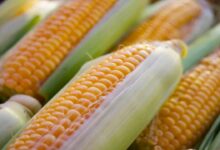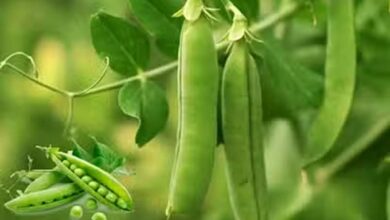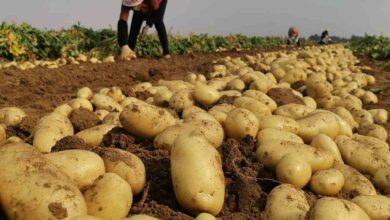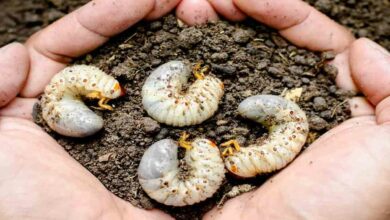Cultivation of Dragon Carrot: How to start growing dragon carrots for beginners, learn step-by-step guide
Cultivation of Dragon Carrot: Dragon Carrot growing is a great option for farmers and gardeners because of its many advantages. Dragon carrots are a favorite among foodies because of their beautiful purple-red skin and vivid orange meat, as well as their sweeter flavor compared to normal carrots. Compared to other crops, growing dragon carrots is simpler since, once planted, they need less maintenance. Because of this, they are a great crop for farmers, both new and seasoned, who want to harvest large amounts of food with little work.

How to start Dragon Carrot Farming
What kind of soil is required?
For dragon carrots to grow healthily, the soil is essential. Sandy, well-draining soil that is somewhat productive is ideal for growing these root crops. It is important to choose a site that receives enough sunshine and has adequate drainage. For Dragon Carrot production, a pH range of 6.0–6.6 is suitable.
Clear away any rocks or other material that can impede your crops’ ability to develop properly while preparing your garden bed. Next, add organic materials to assist enhance the quality of the soil, such as old manure or compost.
After sowing the seeds, water them often but not excessively to prevent waterlogging, which might result in rotting seedlings. To keep your carrots healthy during their development phase, it’s important to keep an eye on them in addition to providing the best growing circumstances for their roots.
How to start farming
Select Your Spot: Pick a location that receives plenty of sunshine, has soil that drains well, and is shielded from severe winds. Prior to planting, make sure the pH of the soil is between 6.0 and 6.6.
Prepare Your Soil: Remove any weeds and rubbish from the location you have selected to establish your Dragon Carrot farm. Using a garden fork, break up the soil and add old manure or compost.
Planting Seeds: Starting in mid-April and continuing through July, directly sow seeds into rows that are spaced about 20 inches apart. Start the seeds in fairly rich sandy soils, at least half an inch deep, and keep them constantly wet until they germinate, which usually takes seven to twenty-one days, depending on the soil temperature.
Watering: To prevent disease growth or root rot, irrigate freshly planted dragon carrots on a regular basis to keep the soil wet.
Fertilizer Application: After two weeks after establishment, fertilizer should be applied according to the directions on the package, being careful not to overfertilize. Rather of allowing adequate root development, this might result in leafy growth.
Control of pests: During the plant establishing stage, apply neem oil-based pesticides once a week to keep pests like aphids at bay. You may also physically remove any visible eggs or larvae to stop them from causing harm.

Advice for growing successfully
Choose a spot with good sun exposure and soil that drains well. Steer clear of waterlogged regions.
For best results, amend your soil with organic matter before to seeding.
For plant development, keep the soil damp but not soggy throughout the germination and growing seasons. The Dragon Carrot plant might suffer from root rot if it is overwatered.
To provide the nutrients required for strong plant development, use a balanced fertilizer at planting time and once again midway through the growing season.
Check your plants often for pests that might harm the production of your crop, such as cutworms, aphids, and carrot fly larvae.
Weeds fight with your crops for nutrients and moisture from the surrounding soil, so be careful to keep them under control. Whenever feasible, use manual tools like hoes or cultivators instead of herbicides since chemicals might kill beneficial insects.
To keep the carrot plants from competing with other plants for nutrition, weed the area surrounding them on a regular basis. Additionally, it is crucial to keep the soil wet since overwatering may lead to rot.
Moreover, mulching the area surrounding the base of the plant keeps the soil wet while keeping weeds at bay. Use natural materials such as leaves that have been shredded or straw.
Throughout the growth season, consistent fertilizing is beneficial for dragon carrots as well. Equivalent amounts of nitrogen, phosphorus, and potassium in a fertilizer will provide vital nutrients without encouraging too vigorous leaf development.
Watch out for pests that might harm your crop of dragon carrots. Aphids and larvae of the carrot rust fly are frequent offenders. Think about using natural pest control techniques like ladybug introductions or companion planting.
Use a garden fork or trowel to carefully remove the tops of the dragon carrots out of the ground without breaking them off at the necks.
Required fertilizers
A vital ingredient in the production of dragon carrots is fertilizer. It assists in supplying the nutrients required for robust plant development and increased harvests. Organic fertilizers are advised since they are better for the environment and people’s health.
Apply fertilizer cautiously; too much fertilizer might cause scorched plants or excessive leaf growth at the cost of root development. During the growth season, it is generally recommended to administer one pound of nitrogen per 1,000 square feet every four weeks.
High-nitrogen fertilizers should be avoided since they might lead to excessive leaf growth and undersized carrot roots. Consider using a balanced fertilizer instead, which has equal amounts of potassium, phosphorus, and nitrogen.
Before planting seeds, filling the planting hole with bone meal or rock phosphate may aid in encouraging root growth and enhancing general plant health.
There are several forms of organic fertilizers, including compost, manure, and bone meal, each with varying nutritional content advantages. While manure delivers significant levels of nitrogen, it should be matured before application to avoid burning plants, compost gives nutrients that release gradually.
Making the right fertilizer choice and application will assist guarantee that your Dragon Carrot crop thrives robustly and healthily.
How to Plant Seeds
When the soil reaches a temperature of 7°C, it is crucial to scatter the seeds thinly in rows. This is often the earliest point in the spring when soil may be worked.
Ensure that the Dragon Carrot seeds are planted at a depth of ¼” and that the rows are spaced about ½” apart. Plants should not be overcrowded since this may hinder their ability to develop healthily.
As your Dragon Carrot seeds germination duration varies from 7 to 21 days based on soil temperature, make sure you keep them continuously hydrated. If you’d like, you may cover them with row cover cloth, which will assist shade and moisten them.
It’s ideal to lightly water your Dragon Carrot seeds often after planting them, but not too much since this might lead to rotting.
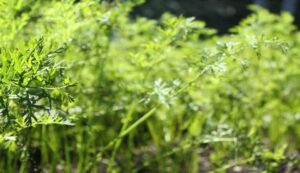
Water requirement
Water Thoroughly: Make sure the soil receives a thorough soaking when you water. Weak roots and stunted development might result from shallow irrigation.
Don’t Let the Soil Dry Out Totally: While it’s not a good idea to overwater your plants, it’s also not a good idea to let the soil go completely bone-dry. The first several inches of soil should always be damp.
Regularly check the moisture levels: To determine when it’s time to water again, pierce the soil with your finger or a moisture meter.
Refrain from Watering Above: Soggy leaves might encourage fungus-related illnesses such as powdery mildew and leaf spots. When you irrigate your plants, try not to get water on the leaves.
Take Drip Irrigation: This technique irrigates plants straight at their bases without soaking the leaves.
Problems Associated with Dragon Carrot
Stunted growth is the most frequent issue seen while cultivating dragon carrots. This may be the result of inadequate nutrients, bad soil, or overpopulation.
Insects and illnesses are additional issues. Aphids, cutworms, and nematodes are a few typical pests that harm carrot plants. Additionally, your Dragon Carrot crop may be harmed by fungal diseases like powdery mildew and leaf spot.
To prevent these issues, make sure your plants get enough light and ventilation. Preventing root rot and nutritional deficits may also be achieved by planting in well-draining soil and fertilizing appropriately.
It’s critical to take immediate action to stop disease outbreaks or insect infestations on your dragon carrots before they spread too far. Monitoring your crops on a regular basis for damage or indications of distress can assist identify any issues early on.
Diseases, Pests and their Management
The carrot rust fly is one of the most frequent pests found close to the base of young plants. The larvae then burrow into the roots, inflicting damage that may result in stunted development or possibly the plant’s demise. As soon as your plants are planted, cover them with row covers to avoid an infestation. Additionally, you may use a floating row cover to keep pests out of them while still letting water and sunshine in.
Disease may be a significant issue for dragon carrots in addition to pests. One such illness is leaf blight, which first turns leaves yellow and brown before penetrating the root system. Avoid planting in places where the disease has already been established and destroy any diseased plants right once in order to manage it. Maintaining healthy soil via frequent compost addition and seasonal crop rotation is another crucial step in guarding against plant pests and diseases.
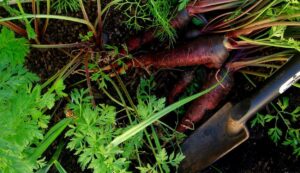
Plant Care
Taking excellent care of your Dragon Carrot plants is necessary to guarantee a plentiful harvest after they have grown. Making sure plants have adequate water is an important part of plant maintenance. Water the soil often to keep it wet, particularly in hot and dry weather.
Fertilization is another essential component of Dragon Carrot plant maintenance. Throughout the growing season, feeding dragon carrots with an organic fertilizer every few weeks is beneficial. This will assist in supplying the nutrients required for robust root development and healthy growth.
It’s crucial to keep an eye out for any illnesses or pests that may be harming your plants. Aphids and flea beetles are common pests, and in humid environments, illnesses like powdery mildew may cause issues. Use natural pest control techniques like neem oil or add beneficial insects like ladybugs to your garden to avoid these problems.
Your taller Dragon Carrot plants need assistance to stay erect and avoid bending or breaking under the weight of their growing stalks. Stakes or cages may be used to support the plants, particularly if they are growing in windy environments.
As your Dragon Carrot plants get closer to maturity, be sure to keep an eye on them so you can harvest when the taste and nutrients are at their peak.
How long does it take to grow?
A novel and fascinating crop that may liven up your vegetable garden are dragon carrots. However, it’s crucial to know how long they take to develop before you begin cultivating them. Dragon carrots are a crop that grows rather quickly, often taking 60–70 days from sowing to harvest. Remember, too, that a variety of things may impact their pace of development.
How and when can harvesting be done?
For every farmer, harvesting dragon carrots is a wonderful time. To acquire the most yield, harvesting at the proper time and with the proper technique is crucial. After 60 to 70 days of planting, dragon carrots are usually ready for harvesting. The carrot tops should grow around three inches tall, and the roots should have a minimum half-inch diameter.
When ready to harvest, grab each carrot by the top and gently take it out of the ground by wriggling it a little. Throughout this procedure, take care not to shatter or damage any carrot parts. Remove any leaves that are still connected to the roots after harvesting, and give them a thorough wash in clean water. Your Dragon Carrots may be kept for up to two weeks in a cool area.
In summary
Growing dragon carrots is an enjoyable and fulfilling hobby that may provide tasty and nourishing produce. Gardening enthusiasts are beginning to take an interest in the unusual and exotic carrot species known as dragon carrots. These carrots have a remarkable appearance because to their vivid orange inside and rich purple skin.

